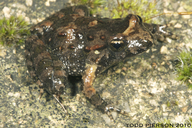|
Discoglossus sardus Tschudi, 1837
Tyrrhenian painted frog, Discoglosse sarde, Sardischer scheibenzüngler, Sapillo pintojo de Cerdeña, Thyrrensk Malet frø, Sardi ketaskeelkonn, Discoglosso sardo, Discoglosso tirrenico, Sardijnse Schijftongkikker, Tyrrhenankirjosammako, Tyrrensk Skivtunggro | family: Alytidae subfamily: Discoglossinae genus: Discoglossus |
| Species Description: Tschudi In Otth, A. 1837. Beschreibung einer neuen europäischen Froschgattung, Discoglossus. Neue Denkschriften der Allgemeinen Schweizerischen Gesellschaft für die Gesammten Naturwissenschaften 1: 1–8. | |
 © 2010 Todd Pierson (1 of 13) |
|
|
|
Description Distribution and Habitat Country distribution from AmphibiaWeb's database: France, Italy
Due to the recent discovery of the cryptic congener D. montalentii, very little is known about the exact distribution and ecology of D. sardus. Earlier studies of on the biology of D. sardus may be attributed to either D. sardus or D. montalentii. However, D. sardus seems to be more common in Corsica than D. montalentii; therefore most of the available information on the ecology of both species may hold for D. sardus (Gasc 1997). Life History, Abundance, Activity, and Special Behaviors Trends and Threats Possible reasons for amphibian decline Loss of genetic diversity from small population phenomena
References
Clarke, B. T. and Lanza, B. (1990). ''Notes on the morphology and distribution of the Corsican Painted Frogs: Discoglossus sardus Tschudi and D. montalentii Lanza, Nascetti, Capula & Bullini.'' Bulletino del museo regionale di scienze naturali, Torino, 8(2), 531-544. Delaugerre, M. and Cheylan, M. (1992). Atlas de Répartition des Batraciens et Reptiles de Corse. L'Oikéma, Pamplona. Gasc, J.-P. (1997). Atlas of Amphibians and Reptiles in Europe. Societas Europaea Herpetologica, Bonn, Germany. Nöllert, A. and Nöllert, C. (1992). Die Amphibien Europas. Franckh-Kosmos Verlags-GmbH and Company, Stuttgart. Originally submitted by: Arie van der Meijden (first posted 1999-09-15) Edited by: Vance T. Vredenburg (2021-01-26) Species Account Citation: AmphibiaWeb 2021 Discoglossus sardus: Tyrrhenian painted frog <https://amphibiaweb.org/species/1528> University of California, Berkeley, CA, USA. Accessed May 12, 2025.
Feedback or comments about this page.
Citation: AmphibiaWeb. 2025. <https://amphibiaweb.org> University of California, Berkeley, CA, USA. Accessed 12 May 2025. AmphibiaWeb's policy on data use. |



 Map of Life
Map of Life